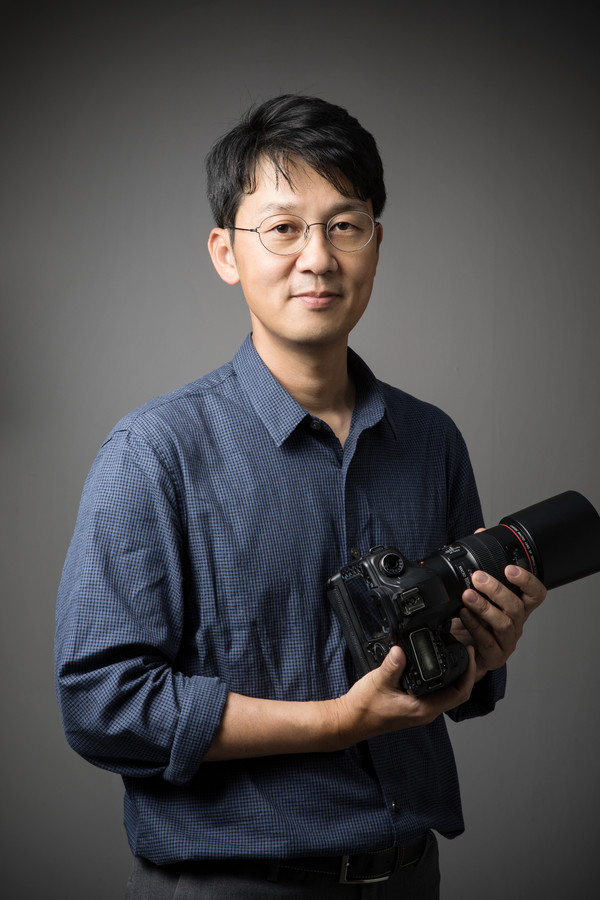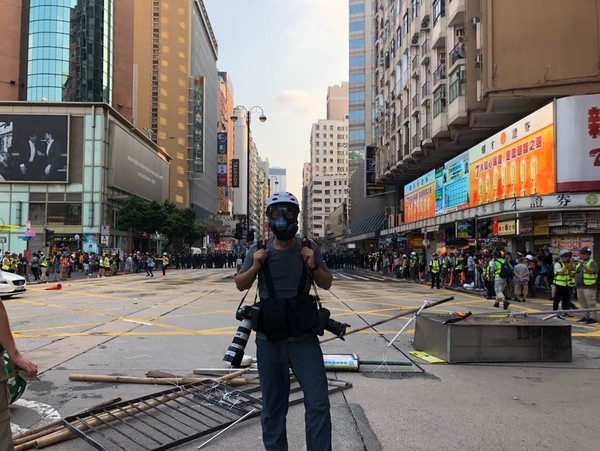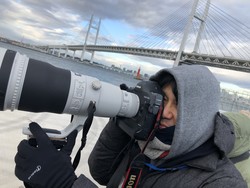What does it mean to read photos, not look at them? Photojournalist Kim Kyung-hoon lets us know what it means through his book ‘Guide you through photos: Hidden stories behind photographs.’ Kim Kyung-hoon is the first Korean photojournalist to win the Pulitzer Prize for Breaking News Photography. The Pulitzer Committee judged his photo as an amazing visual description of the desperate situation of immigrants. He is a great photojournalist who has won several other awards, including the Seo Jae-pil Media Culture Award and the award for the 2020 World Press Photo Contest. It is known that he created a worldwide stir through his photography. Let’s listen to the story of Kim Kyung-hoon who majored in Photography at Chung-Ang University.

Q1. Can you introduce yourself to people reading this article?
Hello, my name is Kim Kyung-hoon. I entered the College of Arts in 1993 and majored in Photography. It’s been over 20 years since I graduated from school. Thank you for meeting me like this.
Q2. You received a master’s degree in Photojournalism at the London College of Communication. When did you get interested in photography?
I got interested in it since high school so I started it as a hobby. Later, I wanted to study in earnest. As it still is today, at that time, Chung-Ang University’s Department of Photography was the best. So since 2nd grade in high school, I studied to go there. Eventually, I entered the university and studied Photojournalism because I wanted to be a photojournalist since I became interested in photography. In addition, the London College of Communication was an online graduate course for current photojournalists. I received a master’s degree from the course.
Q3. Do you have any memorable classes or professors while studying at Chung-Ang University?
There are many memorable professors. But among them, I remember professor Han Jeong-sik the most. I didn’t know back then but now to think of it, his class was very meaningful. When I was a freshman, he gave an assignment which was to take a picture while closing one’s eyes. At that time, I wondered why he gave such an assignment because I wanted to learn professional skills. But now to think of it, I think it was an assignment that helped students think about the meaning that a photograph has. Another thing that I remember is that he told students to take a picture of their parents. At that time, I thought, ‘Did I come here to learn something like this?’ But after I got older and thought about the meaning that photos give us in our lives, I realized that he taught us something basic and gave us a chance to think about many things about photography.
Q4. You won the Pulitzer Prize with other Reuters photojournalists for the caravan incident. Congratulations! What process did you go through to take that photo?
If there’s a big issue around the world that has to be covered for a long period of time, Reuters makes several photojournalists from all over the world into a team and sends them to cover the issue. It’s because since those photojournalists have different races, different backgrounds, and different religions, they can see one event from diverse perspectives. So to talk about the caravan incident, most of the caravans started from Honduras. The coverage began when their journey was half-finished. I covered it while moving together with them. Caravans gathered in front of the Tijuana border where an unexpected event occurred. And the U.S. border guards on the other side of the border, fired tear gas at them. At that moment, I took a photo of a family fleeing from the tear gas. I didn’t go to Mexico just to cover that photo. I was there for about two and a half weeks. I documented day by day and wrote photo articles. I usually wrote 20~30 photo articles a day. Thus, the photo which was rewarded for the Pulitzer Prize was the one among a few hundred photos.
![[ Honduran migrant flees tear gas with her children ] https://reut.rs/34Wikl1](https://cdn.herald.cauon.net/news/photo/202010/20153_10277_749.jpg)
Q5. We heard that to cover dangerous situations, completing a Hostile Environment Course is essential. Can you explain this process?
The company sends only people who have received such education when covering dangerous areas is needed. We’re having a hard time now due to COVID-19 but at that time, I volunteered to cover it. Before going, I had been trained online about infectious diseases. There are many things to learn, such as how to prepare for being in demonstration sites, being kidnapped when covering dangerous areas, and escaping when a fire breaks out. Instructors are mainly those from special forces in the U.K. or the U.S. and there are global companies that specialize in those kinds of education. People learn from those companies’ instructors. In my case, among the dangerous places I went, were the Fukushima nuclear power station, pandemic situations, violent demonstration sites, and war zones. When going to those places, receiving the education is essential to at least protect yourself.
Q6. You also won the 2020 World Press Photo Contest and Pictures of the Year International for your photo ‘Japan’s Veteran Rugby Players.’ Congratulations! What’s the story behind that photo?
Since I’m a photojournalist who delivers news through photos, I follow the news. I don’t just cover something because I want to. I always have to think about what’s happening around me and what kind of news, related to the area I live in, people are interested in. Last year, there was the Rugby World Cup in Japan. It was a big event in Japan like the Soccer World Cup. I came up with an idea of covering how that event is affecting the society, and what kind of link there is between the society and a sports event. There are many words that people think when they think ‘Japan’ and one of them is ‘aging’. I thought about how to match the keywords ‘aging’ and ‘rugby’ to cover fun news that no one has ever covered. Then, I imagined that there can be elderly people who do extreme sports like rugby since an aging society is a society where the elderly do everything. I wondered if there really would be something like that because I haven’t seen any news about that in the Japanese media. But I found one in my research so I could cover it.
Q7. You covered major issues such as tsunami disasters in Southeast Asia, the Great East Japan Earthquake, and the Sewol ferry disaster. Do you feel the pain of the scene when covering those?
I can feel it a lot. When covering those kinds of incidents, usually the misfortune of others is covered more than the happiness of others. People like me have to shoot people crying due to their unhappiness, with a camera, and give a mic to them. For example, when there are people crying because they lost their family during the Sewol ferry incident, I have to ask why they are crying after taking a photo. That’s because I have to fact check and have to know what happened. Therefore, often I feel really bad about it. The Sewol ferry incident was especially hard for me. I also have children so when taking photos during the Sewol ferry incident, I cried and had to stop shooting several times to wipe my own tears away. In addition, I am Korean so I can understand their language. Thus, when I heard the reasons why they were crying and screaming, I felt much more connected and close to them than when I covered other countries’ disaster incidents.
Q8. When covering news, we think you’ll feel a lot of different emotions such as sadness or joy. Do you think that you capture those emotions in photos?
I think the expression “capture” is subjective. It’s not about capturing my feelings; I put others’ feelings and the situation’s atmosphere in the photo. If I put my feelings in the photo, my thoughts and biases will also be there. I am a journalist who works for a news agency. And that agency provides news everywhere in the world, so there shouldn’t be any tone. I think that photojournalists, especially, should be cautious about it. After taking photos, I have to select some that fit the news and sometimes crop them. During that process, information can be delivered unilaterally. Also, writing can explain things at length, but with a picture the explanation should be done in just a single shot. If I unfairly emphasize just one thing, the viewers can’t see other things outside the frame. To overcome that, when covering one event, I send several photos. However, even though I may send 10 photos, there are many cases when the viewers see only one. Thus, I try hard to be as fair as possible with a single photo. It’s my job to report fairly. I have to be faithful to my job. But sometimes it can be captured without me knowing or intending to.

Q9. You worked in the Ilgan Sports photography department since 1999, and you have been a photojournalist in Reuters since 2002. May I ask how you joined both?
When I graduated, it was after the IMF crisis. Therefore, it was hard to get a job. My dream was to be a photojournalist, but sometimes it changed a bit. I was interested in filming and shooting dramas at a broadcasting station. I had experience working at a broadcasting station through my seniors. But after the experience, I felt that it was not a job for me. Thus, I again decided to become a photojournalist. I think internships are a good chance for students to find out what they want to do. When I tried to get a job, the only public opening for photojournalists was a sports newspaper. Thus, I joined Ilgan Sports. I met great superiors there, and I learned a lot from them for three years. This time affected my photojournalist life and helped to nourish that life. One of the hardest news for a photojournalist is sports news. This is because the know-how of taking pictures is different for each sport. Before the 2002 World Cup, Reuters contacted me saying that they were looking for a photojournalist. That’s how I ended up joining Reuters.
Q10. You also published a book "Guide you through photos: Hidden stories behind photographs." Why did you decide to publish it?
At first, I wrote it as a hobby. While working as a photojournalist, there are many times when I must wait for a long time. During that time, I talked with other photojournalists about photography and thought about it alone. In the past, I thought a picture was just taken by a camera. But after so many experiences, I realized that they are very relevant to our society, our life, and so on. I wrote down those thoughts as they came to mind. Besides, I wrote a manuscript about the mystery and hidden stories behind the photographs. I planned to self-publish, but the response was better than I thought. Thus, after my friend's suggestion, I sent the manuscript to the publisher.
Q11. You said that photographers cover news with not only photos but also videos or 3D VR. Have you ever used any other media rather than photos?
I am using various media as well as photos, but what I usually use are photos and videos. These days are a multimedia era. Before, it was difficult for one person to do many things at once because the equipment was big and hard to use. However, with the development of technology, one reporter can, and needs to do various work. I think multitasking is what I want, but also time and technology have made it possible. I think the person who shoots good photography can also take good videos, due to the video being made by many pictures. Therefore, photojournalists are suited for this multimedia era. Besides, there will be a variety of media as time goes by. I will probably try other media. Reporter and photojournalists are very trendy jobs. I have to change myself as time changes.
Q12. To shoot a good photograph, you said to take the family picture first rather than looking for exotic new material. What material did you choose when you first shot photos?

At first, I wanted to buy nice equipment like many people who start photography. Afterward, I looked for places with picturesque scenery. But now, I think those experiences were trial and error. I think I should have shot photos of my family and friends more than fine scenery. When I prepared for the performance test in high school, my teacher told me to take pictures of my school life and students rather than splendid photos. But I didn't understand it very well. I am sad now that I lost those photos. If there were any photos left, it would have been a valuable archive of high school student’s perspective in the 1990s. I also think it is different according to whether I shoot when I am working or traveling, and whether I shoot with a smartphone or camera.
Q13. The technology of smartphone cameras has developed a lot these days, but I think there are still differences between those and DSLR cameras. What is the difference?
The biggest difference is that people look through a viewfinder in a DSLR camera, whereas they look at the screen of a smartphone camera. It may seem like a small difference, but in photography, the difference of 1 second and 1 degree is very large. When I shoot through the viewfinder, the coverage that I can see can get bigger. The second is the technical difference. The quality is similar, but there are differences in focusing and camera lenses. These days, the meaning 'shoot good photos' reenact the situation to capture emotions, not simply a technique.
Q14. What would you want to say to students who dream of becoming a visual journalist?
I think that "there's no bad picture in the world." For example, look at old pictures of your parents at home. If you look at the pictures, you can see that they contain stories and time. I hope that people who take photos as a hobby don't feel too stressed and just enjoy it. I want to say to up-and-coming visual journalists to not obsess about technology too much. I also want to tell them that they need to be able to do various fields now. "I don't know about writing because I am a photographer." That is not right. You should develop various skills. Moreover, diverse platforms such as YouTube are becoming competitors for the press. That’s why I think it is important to be 'flexible.' Think outside the box!

Q15. You defined photography as a language. What stories do you want to share with photos?
Photography is a language and a tool. I think I am a visual storyteller. What I want to talk about with this tool will be different every time. The significant thing is delivering the news as it is. There are two things that I consider crucial in doing this work. First is 'Be a colorless and odorless man when working.' The second is 'Don't make mistakes.' Newspapers have a huge impact on mistakes. In earlier days, I wanted to get a scoop and send a good picture quickly. Over time, I realized that not making mistakes is better even if the process is slower. I also try to give no damage to the person in my picture.
Q16. Do you have any words for Chung-Ang University students?
After graduating from Chung-Ang University, I think that this university is a really good school. Studying at a well-known university becomes a pride and a premium to myself. I hope students feel pride in Chung-Ang University. I also want the students to experience many things in their university time. I think university is a time to dream about what they want to be. There are still many ways to go, so I hope students enlarge their experience as much as they can and enjoy their school life.
During the interview, we could feel that photojournalist Kim Kyung-hoon was proud of his work. Kim Kyung-hoon emphasized being “flexible” without being tied to one thing. He tries to be flexible in the changing times. And it shows that the photographs he shoots are relevant to our lives. CAH hopes his interview to be helpful advice and warm cheer for people interested in photography, and students at Chung-Ang University. His articles and photos can be found on the Reuters website and his Instagram, @kim_reuters_photojournalist.

